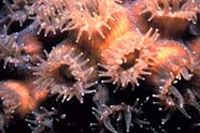Coral Reef Biology and Formation
If you have ever seen branching corals spreading their arms out like tree limbs, you can see why early scientists thought corals were plants. But these tiny, soft-bodied creatures are carnivores, despite being sessile, or fixed to one spot. Like their relatives, the jellyfish and the sea anemone in the Cnidaria phylum, each individual coral, or polyp, has barbed, stinging cells called nematocysts it can extend to capture prey like zooplankton or small fish.
Although those early scientists got it wrong, it's easy to understand their mistake. Coral almost could be considered half-plant because of the zooxanthellae (pronounced zoo-zan-thelly) algae that live just inside each polyp's cell walls. The zooxanthellae supplies the polyp with the byproducts of photosynthesis, which the polyp turns into proteins, fats and carbohydrates. In turn, the polyp shelters the zooxanthellae and provides the carbon, nitrates and phosphates the algae need for photosynthesis. Up to 90 percent of the energy produced by zooxanthellae's photosynthesis is transferred to the coral host [source: NOAA]. This mutually beneficial arrangement is called symbiosis.
Advertisement

Coral polyps also use the energy supplied by their symbiotic algae to produce calcium carbonate, or limestone. They secrete the limestone from their base, creating a protective skeleton and a hollow chamber called a cup. The polyps retreat into their cup to hide when predators come looking for them.
Polyps rarely exist alone. They usually join other polyps to form a larger colony that acts as a single organism. While the individual minuscule polyps grow to 1 millimeter to 3 millimeters on average, colonies can weigh tons. Even a single branching coral comprises thousands of individual polyps. Over hundreds or thousands of years, these colonies may connect to form a reef.
Reefs grow in one of two ways. One way is to periodically add on to their limestone base. They simply secrete more calcium carbonate under and around their current cup, creating the framework of the reef and causing it to grow both upwards and outwards. They also grow by reproducing. Corals may reproduce either asexually, by dividing and producing identical clones, or sexually, by sending out eggs or sperm.
Either way, new coral polyps settle towards the ocean bottom until they find a hard substrate to call home, either combining with a pre-existing coral colony or starting one of their own. In addition to being connected at their bases, coral polyps link to one another laterally by a thin tissue called the coenosarc. The coenosarcs and the polyps form the visible living part of the reef, while the limestone base forms the non-living part.
On the next page, you'll learn more about the structure of a coral reef and find out what conditions they need to survive. You'll also get a look at the different kinds of reefs.
